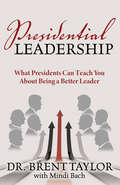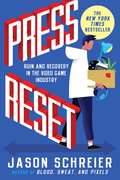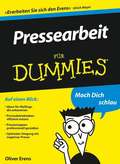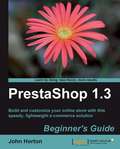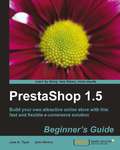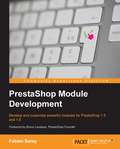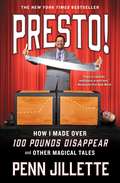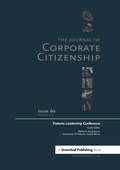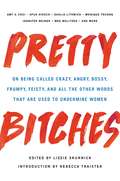- Table View
- List View
Presidential Leadership: What Presidents Can Teach You About Being a Better Leader
by Dr. Brent Taylor Mindi BachFrom across history and across the aisle, the examples of twenty-one American presidents demonstrate how to inspire and unite in this leadership guide.Harry Truman once commented, "In periods where there is no leadership, society stands still." In Presidential Leadership, Dr. Brent Taylor sets out a series of timeless leadership lessons drawn from presidential history. Pairing two presidents per chapter, Taylor explores the leadership skills they shared, and how we can apply them to our own lives.At a time when political tribalism is on the rise, Presidential Leadership demonstrates that we can learn important lessons even from those with whom we disagree. From Lincoln and Nixon, to JFK and Obama, to Trump and Jackson, each chapter tells a story of courage under immense pressure, and a determination to lead American through the trials of history.
Presidential Power: The Politics of Leadership with Reflections on Johnson and Nixon
by Richard E. NeustadtBased on an underlying theme of Presidential weakness, this book characterizes the powers of a modern American president in terms of his personal influence on government action.
Press Box Revolution: How Sports Reporting Has Changed Over the Past Thirty Years
by Rich CoutinhoPress Box Revolution is a journey through the evolution of reporting in New York and around the nation by a reporter who has witnessed every second of it in the past three decades. Rich Coutinho, a New York-based reporter who has covered numerous major sporting events, will escort readers into corners of the press box and locker room they have never seen and discusses what the business will look like down the road. Coutinho gives an insider’s view of the evolving technology in the business, the growth of women in sports creating much needed diversity in the reporting landscape, the emergence of sports talk radio and the Internet, as well as the personalities on the New York sports scene that make it so challenging to cover. Press Box Revolution lifts the curtain on all the myths about how sports is reported and it will help fans realistically evaluate the information they read and hear that is labeled "Breaking News” or "Insider Report.” It is a must-read for all well-informed fans and aspiring sports journalists.
Press Reset: Ruin and Recovery in the Video Game Industry
by Jason SchreierFrom the bestselling author of Blood, Sweat, and Pixels comes the next definitive, behind-the-scenes account of the video game industry: how some of the past decade's most renowned studios fell apart—and the stories, both triumphant and tragic, of what happened next.Jason Schreier's groundbreaking reporting has earned him a place among the preeminent investigative journalists covering the world of video games. In his eagerly anticipated, deeply researched new book, Schreier trains his investigative eye on the volatility of the video game industry and the resilience of the people who work in it.The business of videogames is both a prestige industry and an opaque one. Based on dozens of first-hand interviews that cover the development of landmark games—Bioshock Infinite, Epic Mickey, Dead Space, and more—on to the shocking closures of the studios that made them, Press Reset tells the stories of how real people are affected by game studio shutdowns, and how they recover, move on, or escape the industry entirely.Schreier's insider interviews cover hostile takeovers, abusive bosses, corporate drama, bounced checks, and that one time the Boston Red Sox's Curt Schilling decided he was going to lead a game studio that would take out World of Warcraft. Along the way, he asks pressing questions about why, when the video game industry is more successful than ever, it's become so hard to make a stable living making video games—and whether the business of making games can change before it's too late.
Press Start to Continue: What's Next for Gamers--And Us?--The Business Impact of the Gamer Generation
by John C. Beck Mitchell WadeThough they seem an unlikely path to greatness, video games have created a generation with much more potential than your average baby boomer might imagine or even acknowledge. But as high as gamers' potential is to be great professionals, great team players, and even great executives, the change is just beginning to unfold. The lasting effects of the gamer generation will no doubt become clear eventually--this chapter considers some of the possibilities. This chapter is excerpted from "The Kids Are Alright: How the Gamer Generation Is Changing the Workplace."
Pressco, Inc.--1985
by William E. FruhanA capital budgeting problem is viewed from the context of a marketing representative attempting to make a sale of energy saving heavy industrial equipment. Tax law changes promise to have a significant impact on the customer's decision process. Teaching purpose: To surround the capital budgeting decision with the complexities often found in the actual decision making process. These include taxes, inflation rates, and uncertainty about cost savings to be realized.
Pressearbeit für Dummies (Für Dummies)
by Oliver ErensDie Presse, das unbekannte Wesen, wie erregt man ihre Aufmerksamkeit, gewinnt sie für sich und behält ihre Gunst? In diesem Buch finden Sie Tipps, Tricks und Kniffe des Presse-Profis Oliver Erens. Er zeigt Ihnen, wie Sie Presseverteiler sowie Netzwerke aufbauen und pflegen, Meldungen verfassen, Pressekonferenzen vorbereiten, durchführen und nachbereiten. Außerdem erklärt er Ihnen, wie Sie eine Pressemappe gestalten sollten, welche Strategie für Sie die richtige ist und wie Sie Pressearbeit in Krisen richtig angehen.
Pressure Makes Diamonds: Becoming the Woman I Pretended to Be
by Valerie GravesThe powerful memoir of a female African American advertising executive's unprecedented, unlikely success, which began in the Mad Men era. “When you get dealt a tough hand, you might choose to fold or you might decide to hold. If you’re Valerie Graves, you reshuffle the whole damn deck . . . Graves’s can’t-stop-won’t-stop energy offers a jump start toward meeting objectives and renews hope. Pressure Makes Diamonds is about more than overcoming.” —Essence Magazine This is the unflinching memoir of a female African American advertising executive’s unprecedented and unlikely success, which began in the Mad Men era. It follows her journey from the projects of Motown-era Michigan to the skyscrapers of Madison Avenue and beyond. With marches, riots, and demonstrations as the backdrop, and rock ’n’ roll as a soundtrack, this book accompanies Graves as she traverses the seismically shifting terrain of 1960s and ’70s America on her quest to “be somebody.” In the ’80s and ’90s, as Graves makes her ascent to the East Coast heights of the white male–dominated advertising world, she turns familiarity with harsh realities like racism and sexism into robust insights that deeply connect with African American consumers. During the golden era of black advertising, she becomes an undisputed “somebody.” Soon, though, she learns that money, success, a good marriage, and connections that reach all the way to the White House cannot entirely insulate her against the social ills that threaten to crush black Americans.
PrestaShop 1.3 Beginner's Guide
by John HortonThe book is structured so that following the chapters in order leads to building a fully functioning and live trading PrestaShop. Guidance is also given should you wish to learn or practice your skills in an offline, non-trading environment. Every chapter contains clearly structured and illustrated step-by-step explanation to achieve the goals discussed. Nothing is left for readers to work out themselves, but it would be very simple for them to use the information to go beyond the specific tutorials, should they wish to do so. There is optional additional reading, including more than a dozen specifically written downloadable e-books made available on the book's support website just for readers of PrestaShop 1.3 Beginners Guide. This book is for anybody who wants a fully functioning e-commerce store using PrestaShop. You do not have to have any previous knowledge of PrestaShop or any aspect of e-commerce or business in general. If you do, then you will probably find this guide really valuable as well. The book covers all you need to know about starting your own e-commerce business.
PrestaShop 1.5 Beginner’s Guide
by John Horton Jose A. TizonThis book is written in a friendly voice with lots of tips, tricks, and screenshots to help you set up, extend, and personalize your own online shop. If you want to start your own e-commerce business, then this book will help you do that.This book is for people who are interested in creating an online shop. Basic HTML and CSS skills would be beneficial but are not required as we will provide you with all the code and know-how you need.
PrestaShop Module Development
by Fabien SernyIf you are a developer who is new to PrestaShop and wants to get a good foundation in development on the PrestaShop framework, this book is for you. It's assumed that you will have some experience with PHP5, jQuery, and HTML/CSS (no need to be an expert on it).
Prestando Dinero: ... y evitando a los usureros! (Cómo... #92)
by Owen JonesPrestando Dinero ... y evitando a los usureros! Espero que encuentre los artículos útiles y rentables. La información de este libro electrónico sobre cómo obtener las mejores ofertas al pedir dinero prestado y temas relacionados está organizada en 17 capítulos de entre 500 y 600 palabras cada uno. Le ayudará a mejorar la forma en que aborda la financiación y los préstamos con consejos y sugerencias útiles. También debería darle ideas sobre cómo mejorar los métodos que ya está haciendo. Pedir dinero prestado se ha vuelto más común que en cualquier otro momento en décadas, debido al estado de las economías mundiales después de los estragos de la epidemia de Covid y los consiguientes estragos de la inflación y el desempleo. Como beneficio adicional, le doy permiso para usar el contenido en su propio sitio web o en sus propios blogs y boletines, aunque es mejor si primero los vuelve a escribir con sus propias palabras. De hecho, el único derecho que no tienes es el de revender o regalar el libro tal como te lo entregaron.
Prestige Telephone Co.
by William J. Bruns Jr.An independent regulated telephone company has established a computer services subsidiary that seems to remain unprofitable. Managers must determine whether it is profitable or not and consider changes in pricing or promotion that might improve profitability. A rewritten version of an earlier case.
Presto!: How I Made Over 100 Pounds Disappear and Other Magical Tales
by Penn JillettePenn Jillette’s New York Times bestselling account of his “extremely funny and somewhat profane journey to discovering a healthy lifestyle…that will motivate others to seek weight-loss solutions” (The Washington Post).More than three hundred and thirty pounds and saddled with a systolic blood pressure reading at dangerous heights, legendary magician Penn Jillette found himself at a crossroads. He needed a drastic lifestyle change if wanted to see his small children grow up. Enter Crazy Ray. A former NASA scientist and unconventional, passionate innovator, Ray Cronise changed Penn Jillette’s life with his wild “potato diet.” In Presto, Jillette takes us along on his journey from skepticism to the inspiring, life-changing momentum that transformed the magician’s body and mind. He describes the process in hilarious detail, as he performs his Las Vegas show, takes meetings with Hollywood executives, hangs out with his celebrity friends and fellow eccentric performers, all while remaining a dedicated husband and father. Throughout, he weaves in his views on sex, religion, and pop culture, making his story a refreshing, genre-busting account. Outspoken, frank, and bitingly clever, Presto is an incisive, rollicking read. In the end, it is “undeniably inspiring” (Booklist).
Preston Tucker and His Battle to Build the Car of Tomorrow
by Jay Leno Steve LehtoIn the wake of World War II, the U.S. automobile industry was fully unprepared to meet the growing demands of the public, for whom they had not made any cars for years. In stepped Preston Tucker, a salesman extraordinaire who announced the building of a revolutionary new car: the Tucker '48, the first car in almost a decade to be built fresh from the ground up. Tucker's car, which would include ingenious advances in design and engineering that other car companies could not match, captured the interest of the public, and automakers in Detroit took notice. Here, author Steve Lehto tackles Tucker's amazing story, relying on a huge trove of documents that has been used by no other writer to date. It is the first comprehensive, authoritative account of Tucker's magnificent car and his battles with the government. And in this book, Lehto finally answers the question automobile aficionados have wondered about for decades: exactly how and why the production of such an innovative car was killed.
Presupuesto para Principantes: La guía definitiva sobre cómo salir de la deuda y comenzar a generar riqueza financiera
by Adidas WilsonDecidir que necesita crear un presupuesto es una cosa. Crearlo y ejecutarlo es otra. Esto es algo que muchas personas conocen y comprenden. Algunos siguen adelante y crean un presupuesto, e incluyen metas financieras que no son realistas. Pero si usted desea presupuestar con éxito, debe considerar una estrategia de varios pasos en lugar de cometer errores comunes al presupuestar o tener excusas presupuestarias. Si ha intentado hacer un presupuesto antes y ha fallado, intente incorporar estos pasos la próxima vez. La gente falla por muchas razones. Uno de ellos es tener poca fe en los presupuestos y no ver cómo pueden ayudarlo a mejorar su situación financiera. Puede sentir que no gana lo suficiente para su presupuesto. Entonces, antes de comenzar a presupuestar, establezca sus metas.
Pretoria Leadership Conference: A special theme issue of The Journal of Corporate Citizenship (Issue 60)
The Albert Luthuli Centre for Responsible Leadership invited papers related to responsible leadership from a trans-disciplinary perspective involving the social and natural sciences. Subsequent to a lengthy review process, fifteen authors were invited to present at the the 3rd International Conference on Responsible Leadership; from these, five papers were finally selected to appear in this Special Edition.Management, leadership, and business knowledge by itself cannot ensure a sustainable and equitable future. What is needed is an integration of knowledge about responsible leadership across disciplinary boundaries, ranging from management studies and the physical sciences, to law, the humanities and social science. Only by integrating across current disciplinary boundaries can we find hope for generating what has been termed “earth system governance”, a way for humanity to manage the complexities of the world to create a just, equitable, and sustainable world for all.The five papers included in this special edition provide insight into responsible leadership and the importance of interdisciplinary dialogue in an interconnected and complex world. The perspectives converge to give us focused insights on responsible leadership as an emerging discourse, confirming the importance of bridging science, business and politics, and the role that responsible leadership plays in this.
Pretransformation: Planting the Seeds
by Behnam TabriziPretransformation is the first stage of a transformation effort and holds special importance in setting the tone for the effort. This chapter examines the general steps you must take to plant the seeds for a successful transformation effort, from how to select a transformation leader to how to gain buy-in and momentum.
Pretty Bitches: On Being Called Crazy, Angry, Bossy, Frumpy, Feisty, and All the Other Words That Are Used to Undermine Women
by Lizzie SkurnickThese empowering essays from leading women writers examine the power of the gendered language that is used to diminish women -- and imagine a more liberated world.Words matter. They wound, they inflate, they define, they demean. They have nuance and power. "Effortless," "Sassy," "Ambitious," "Aggressive": What subtle digs and sneaky implications are conveyed when women are described with words like these? Words are made into weapons, warnings, praise, and blame, bearing an outsized influence on women's lives -- to say nothing of our moods.No one knows this better than Lizzie Skurnick, writer of the New York Times' column "That Should be A Word" and a veritable queen of cultural coinage. And in Pretty Bitches, Skurnick has rounded up a group of powerhouse women writers to take on the hidden meanings of these words, and how they can limit our worlds -- or liberate them. From Laura Lipmann and Meg Wolizer to Jennifer Weiner and Rebecca Traister, each writer uses her word as a vehicle for memoir, cultural commentary, critique, or all three. Spanning the street, the bedroom, the voting booth, and the workplace, these simple words have huge stories behind them -- stories it's time to examine, re-imagine, and change.
Pretty Good Advice: For People Who Dream Big and Work Harder
by Leslie Blodgett“[A] new literary genre, the MBA Memoir . . . Delivers 97 pearls of warmth, wit and wisdom from the most inspirational entrepreneur I have ever met.” —Frances Edmonds, bestselling author of Repotting Your Life Called the “Queen of Beauty” and the most influential lone woman to impact the beauty industry since Estée Lauder by the New York Times, Leslie Blodgett’s story is anything but ordinary. As the CEO of BareMinerals, she reinvented how beauty was sold by tapping into the power of community before the idea of social media existed. In 2006, Blodgett took the company public in one of the largest cosmetic IPOs of the decade, and in 2010, the company was acquired for $1.8 billion. Pretty Good Advice is her next chapter. This refreshing book features 97 candid and entertaining insights on business, life, and beauty. Personal and often surprising, Blodgett dishes on leading with humor, why wearing blush and reading obituaries are two of the most optimistic things you can do, and why you owe it to your coworkers not to be boring. Pretty Good Advice is full of frank, actionable advice to help light a fire under you.“If you want to laugh, get totally inspired, learn a bunch and enjoy reading something so engrossing you won’t put it down but you could because it’s written in these amazing one-ish-page chunks, GET IT. Could not be better for right now.” —Jean Godfrey June, Beauty Editor, GOOP“A moving and clear-eyed memoir of an extraordinary life. Charmingly made-up as a how-to guide, Leslie chronicles that life in vivid and memorable lessons that jump off the page.” —John W. Evans, author of Should I Still Wish
Pretty Powerful: Appearance, Substance, and Success
by Eboni K. WilliamsFOX News co-host and radio personality Eboni K. Williams believes that women shouldn’t hide their beauty. Instead, they should embrace it as a positive and powerful asset. Williams describes how her own career has been positively influenced by making strategic and intentional decisions about her appearance, what works best and when, all while staying true to her own personal style and values. Regardless of the decade, whether they were entering the workforce, seeking a leadership role, or looking to ascend to the C-suite, women (and even men) have always felt the professional need to embody a certain aesthetic appeal and individual personal power. Women, especially, have been sold the lie that being “pretty” comes at the expense of being taken seriously and that being “pretty” and being capable are mutually exclusive. In PRETTY POWERFUL, Eboni K. Williams encourages readers to reject the knee-jerk reaction to be shamed by this potential advantage and to stop leaving this incredibly powerful asset unused. In each chapter, Williams is joined by other powerful women like Meghan McCain, Marcia Clark, and Desiree Rogers and explores how many others have learned to balance their “prettiness” with substance—to both look the part and express their intelligence in a way that is authentic and respected. While opinions may have differed through time, one fact remains: a personal “pretty” brand is perhaps the most immediate and obvious tool in a woman’s professional arsenal.
Prevailing Worldviews of Western Society since 1500
by Glenn Richards MartinThis text is a concise study of the conflicting worldviews we face today. It is published from lectures and retains the author's engaging style. Dr. Martin analyzes the structures and procedures which inform government, law, economics, and international relations. He links these institutions to their underlying philosophical and theological roots.
